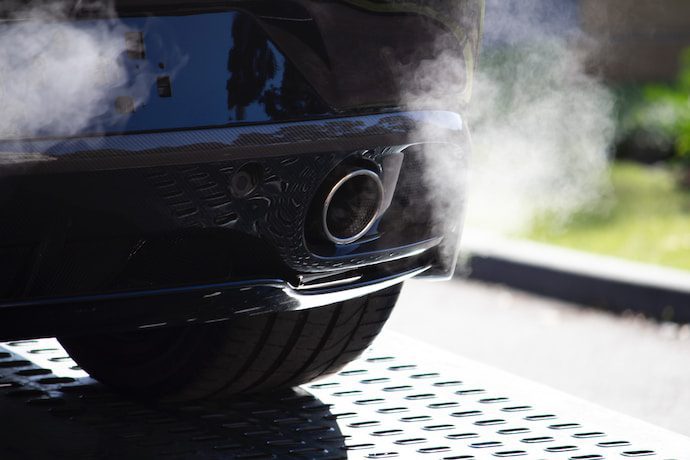
Learn about Water Dripping from your Exhaust: Causes and Solutions.
The exhaust plays a fundamental role of releasing exhaust gases into the atmosphere from the car. The internal combustion engine runs through the ignition of air/fuel mixture.
During combustion gases are released which are first sent to the catalytic converter before being expelled to the air. The catalytic converter will remove harmful hydrocarbons from the gases so that what is expelled is environmentally friendly.
It can be worrying to see water dripping from your exhaust. Most of the time it is not a cause of concern as the water is what had condensed in the exhaust pipes but other times it could be a symptom of serious engine trouble.
What are some possible causes for water dripping from exhaust?
Condensation of water
This is mostly the most common reason for seeing water drippings on the exhaust. One of the byproducts of the internal combustion engine is carbon dioxide and water. When the engine is running, this will come out of the tailpipe as vapor; hence it is not noticeable.
But, when it cools, some water condenses on the tailpipe, hence being expelled as water droplets. The water droppings are more visible if you live in a very cold place. You will also notice them when you start your car early in the morning. This should not worry you as it clears as you continue driving your car.
The catalytic converter is responsible for removing some of the harmful hydrocarbons present in exhaust gases, and water is one of the byproducts. This is safe for the environment.
Faulty Pistons
Here we are talking about engine replacement or even scrapping the car. The essence of the fuel/air ignition is to move the pistons that then turn the crankshaft hence moving the car.
The moment you have a faulty piston, your fuel is not being completed combusted. This soon finds its way into the tailpipe. The water drippings will be accompanied with white smoke that smells of fuel.
When the problem of faulty piston rings is compounded, you will notice a burning smell or sweet aroma fill out your cabin. You must stop the car, turn off the ignition and drive your car to the next auto repair shop.
Engine Heat
This is another normal cause of water droplets from the engine that should not worry you. This is especially the case if you live an area that experiences extreme cold weather. When you switch on your engine in the morning, there is a lot of heat generation as oil starts circulating through the entire system.
When exposed to the cold air outside, this hot air condenses, forming the water droplets you normally see from your exhaust. This soon clears out as you continue driving your car and the engine gets cooled.
Types of exhaust smoke colors
Before you can get into fixing your exhaust, you must be familiar with some of the type of exhaust colors.
Light white smoke
This is the most common form of smoke from the exhaust. It is also the least harmless to your car. What you see as a thin white smoke is water vapor that has condensed. You will experience this kind of smoke in almost all gasoline cars. It clears out after a few miles.
Blue/gray exhaust smoke
This should worry you. It means your car is burning oil or you have some oil leaks that find its way to the combustion chamber. This should be checked immediately as oil is vital for lubrication and heat dissipation. Oil leaks are common if you have damaged piston rings, worn cylinder walls or your valves are leaking.
You should observe when the bluish smoke is at its highest. If it is during acceleration, your piston rings are faulty.
However, if you notice that the bluish smoke only comes when you are decelerating, it could indicate that your cylinder head valve guides are faulty. Bluish smoke should never be ignored because oil leaks lead to engine overheating and will destroy other engine components.
Black Exhaust smoke
You have probably seen an old car emit thick black smoke anytime it goes to the road. The main reason is that your car is combusting more fuel than normal. This is the kind of smoke you should not ignore.
Possible causes of black smoke include faulty fuel injection systems, clogged air filter, or a manifold is blocked. You should have this fixed as you spend more on fuel that usual.
Continued thick white smoke
While the thin white smoke is normal having a thick one the moment you start accelerating is dangerous. This is a signal that you have blown out your head gasket.
If not treated immediately it will lead to your engine overheating. If you do not check the problem immediately, you will see more engine damage, hence rising repair costs.
Possible fixes
For the normal condensation of water droplets when the engine is hot in the morning there is little that is required of you as it soon clears. However, if one of your pistons is faulty, you must have it checked and fixed immediately.
You may also want to inspect the exhaust pipes for any signs of leaks physically. However, please do not attempt to check then when it is hot as it will burn your hands. The color of the smoke from the tailpipe should give you possible causes for the problem.
If you notice a thick black cloud, your fuel is not being fully ignited in the combustion chambers. This could be a problem with your spark plugs. If the white smoke has traces of a bluish color it could signal oil leakages to the combustion chambers.
Lack of proper fuel ignition will lead to fuel inefficiencies and you will constantly run low on gas.
If you notice that the white smoke does not clear out even after driving for a few miles, it could mean that your car has blown out its head gasket. The other reason would be that you have a cracked cylinder head.
This will necessitate you to dismantle the engine and repair the cracked head. Your mechanic may recommend replacing the cracked cylinder head with a salvage one or purchasing a new one.
The other kind of smoke from your car is the bluish one. This means your oil is finding itself inside the combustion chamber. The main cause would be leaking valve seals, worn piston rings or stuck PVC.
Cost of repairs
If the main reason of the water drippings is faulty pistons, then you will need to purchase new ones before they cause further engine damage. Most of the mechanics charge around $200 to repair water drippings from the exhaust but this varies with the extend of engine damage. The repair time can be a few minutes to an hour.
Conclusion
Water drippings are normal and should not concern you. However, when they are accompanied with various smoke colors, you need to note them. Having a continued white smoke the moment you start driving the car indicates that your head gasket is blown.
If you notice a bluish smoke, your oil could leak while a thick black smoke means your engine is not burning fuel efficiently. Have the problem checked immediately to avoid further engine damage.
